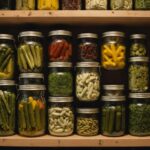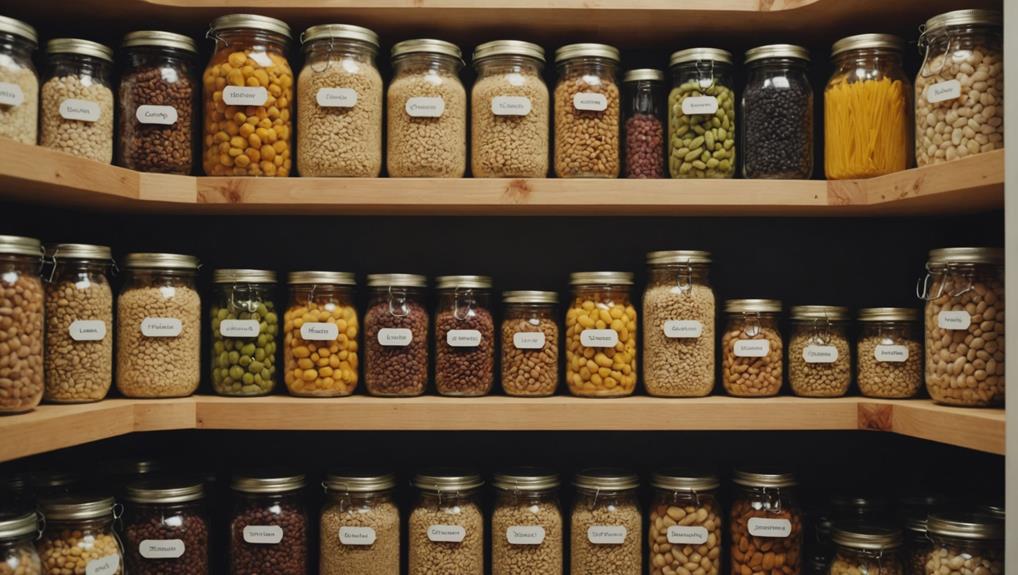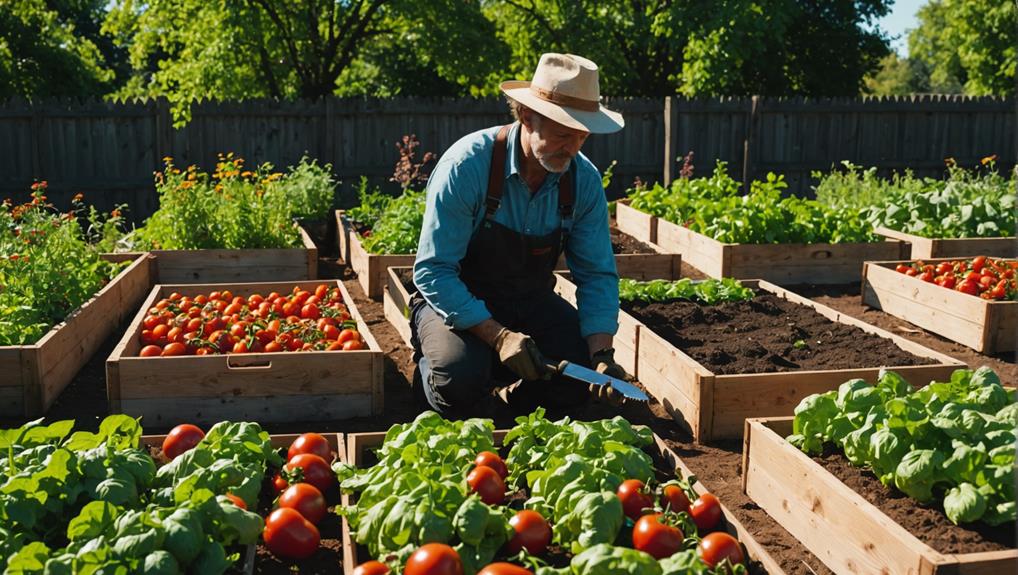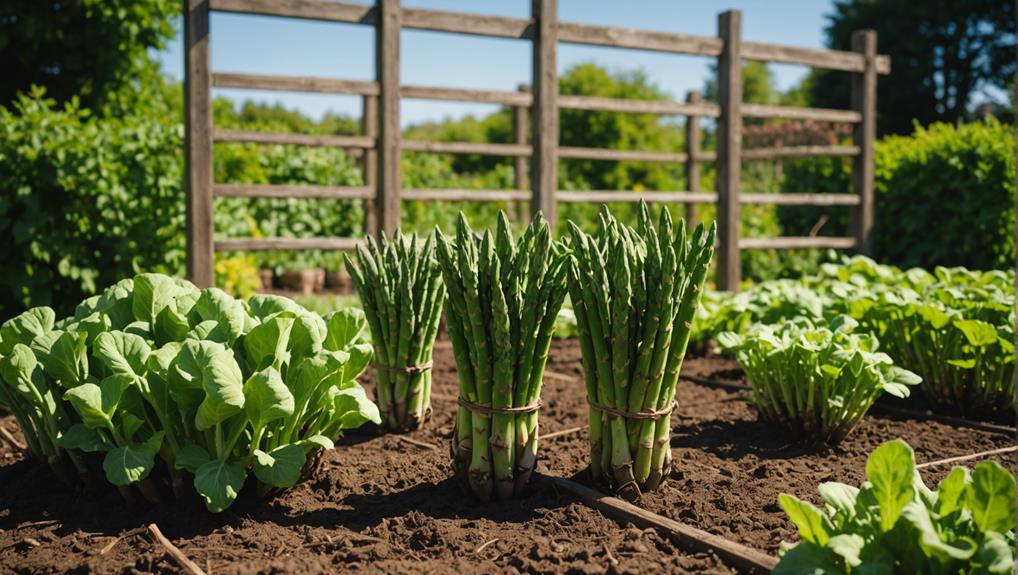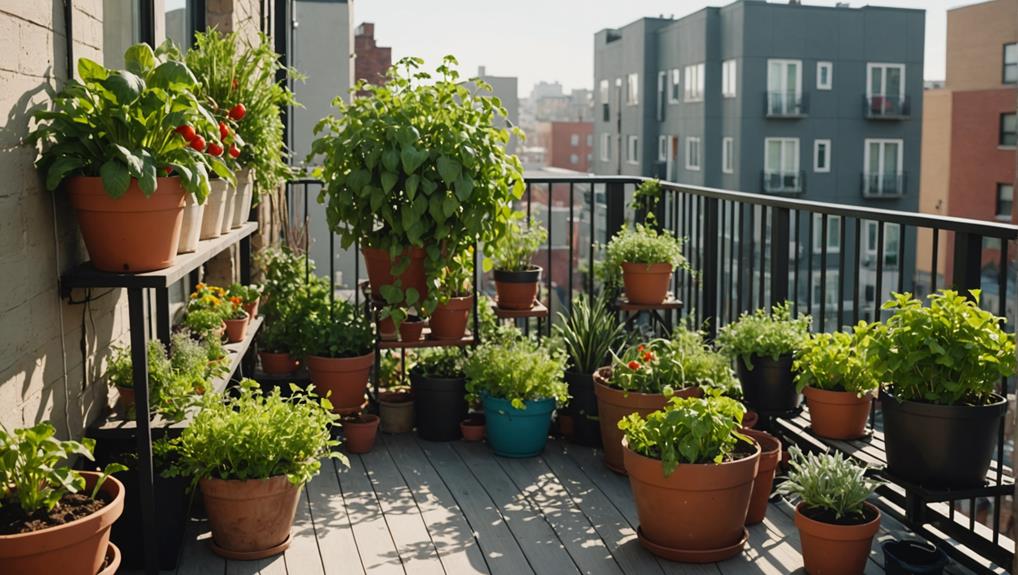As an Amazon Associate I earn from qualifying purchases.
When you're preparing for emergencies, choosing the best foods for long-term storage isn't just about grabbing any non-perishables off the shelf. You need to think about nutrient density, shelf stability, and variety to guarantee a balanced diet that can sustain you and your family. It's crucial to understand which bulk staples like rice and grains are worth stocking up on, and how to keep them fresh for the long haul. But how do you avoid common pitfalls and guarantee your storage strategy is effective? Let's explore the key factors that can make or break your emergency food supply.
Authors and Expertise
Judy Harrison, Ph.D., and Elizabeth Andress, Ph.D., are renowned professors and Extension Food Safety Specialists with extensive expertise in food safety and emergency preparedness. Their deep knowledge in food storage strategies and emergency food supply has proven invaluable for anyone looking to build a prepper pantry. By understanding the fundamentals of long-term food storage, they guide you in maintaining food safety and guaranteeing nutrition during crises.
These experts emphasize the importance of including non-perishable foods in your emergency food supply. Non-perishables are ideal for long-term storage and can be life-saving during emergencies. Harrison and Andress advocate for balanced nutrition, stressing that even in crisis situations, your stockpile should include a variety of foods rich in essential vitamins and minerals. This guarantees you meet your nutritional needs when fresh foods are unavailable.
Their expertise in food preservation also plays a critical role. They offer practical advice on how to extend the shelf life of your food supplies while retaining their nutritional value. By following their guidelines, you'll be better prepared for any emergency, with a well-rounded, safe, and nutritious food reserve.
Emergency Food Preparation
When preparing food for emergencies, focus on meeting your daily nutritional needs by ensuring you have at least one well-balanced meal each day.
Don't forget to stay hydrated; aim for two quarts of liquid daily to avoid dehydration.
Stock up on vitamin, mineral, and protein supplements to maintain nutrition when fresh food isn't available.
Daily Nutritional Essentials
In an emergency, it's essential to guarantee you have at least one well-balanced meal each day to maintain your strength and energy levels. Your emergency food supply should focus on providing high nutritional value to meet your body's fundamental nutrient requirements. Here's how you can make sure you're covered:
- Nutrient-Dense Foods: Stock up on foods high in calories and rich in essential nutrients. Items like canned beans, nuts, and whole grains are great choices due to their long shelf life and nutritional density.
- Protein Supplements: Incorporate protein supplements into your emergency food supply to address any potential gaps. These supplements can help maintain muscle mass and overall health, especially when fresh meat or dairy isn't available.
- Variety in Menus: Guarantee a variety of foods in your storage to cover a broad range of nutrients. Diverse menus can prevent diet fatigue and ensure you're getting a thorough mix of vitamins and minerals.
Meeting your daily caloric needs is critical when planning your long-term food storage. By prioritizing nutrient-dense, high-calorie foods, and including protein supplements, you'll be better equipped to stay healthy during any emergency.
Hydration and Liquid Needs
Guaranteeing you have adequate hydration is essential for maintaining health during an emergency. You should store at least two quarts of water per person daily. Water will be your primary focus, but don't forget about comfort drinks like tea and coffee. These can boost morale and should be stored in airtight containers to maintain freshness.
Consider including electrolyte solutions in your stockpile. These drinks help replenish lost minerals during high-stress situations or physical exertion. It's critical to store water and other liquids in food-grade containers to guarantee safety and longevity. Avoid using containers that previously held chemicals or non-food substances.
Regularly check and rotate your stored liquids to make certain they remain safe and effective. Replace any that show signs of contamination or degradation. Keeping a schedule for rotating your stock can help you stay organized and ensure nothing goes to waste.
In emergency situations, having a reliable supply of safe, stored liquids is essential. By prioritizing hydration and using the right containers, you can maintain safety and comfort for you and your family.
Supplement Stockpiling Strategies
Stockpiling a variety of supplements guarantees you meet fundamental nutritional needs when fresh food is scarce. To make certain you maintain adequate nutritional intake during emergencies, consider a well-rounded approach to supplement stockpiling.
Protein Supplements: Protein supplements, such as whey or plant-based protein powders, are essential. They help meet daily protein requirements when traditional protein sources are limited. This is important for muscle maintenance and overall energy levels.
Multivitamins: These provide a broad spectrum of essential nutrients that might be missing in a limited diet. Multivitamins make certain you get the necessary vitamins and minerals to support your immune system and overall health, especially during extended periods without fresh produce.
Electrolyte Supplements: In high-stress situations or during physical exertion, electrolyte supplements aid in hydration and replace lost minerals. They're crucial for maintaining proper body functions and preventing dehydration.
Store all your supplements in airtight containers and keep them in a cool, dry place to maximize their long shelf life and effectiveness.
Food Storage Strategies
When planning your long-term food storage, focus on a mix of bulk staples and canned goods to create a balanced supply.
Make sure to store these items in clean, dry, and dark areas to maximize their shelf life.
Using airtight containers and rotating your stock regularly will help keep your food fresh and minimize waste.
Bulk and Canned Foods
Regularly stocking up on bulk staples like rice, pasta, and grains, along with canned vegetables, fruits, and meats, guarantees you've got a versatile and reliable emergency food supply.
Bulk items and canned goods are fundamental for long-term storage due to their long shelf life and minimal preparation requirements. Use the FIFO method to manage your food rotation, ensuring older items are consumed first to prevent spoilage.
For an effective emergency food supply, follow these steps:
- Choose Long-Lasting Items: Opt for foods with at least a one-year shelf life. Dry ingredients like rice and pasta, stored in air-tight containers, can last several years.
- Diversify Your Storage: Incorporate freeze-dried foods, which offer longer shelf life compared to traditional canned goods, and store them in dry, dark areas to maintain quality.
- Monitor Canned Goods: Commercially canned foods, such as vegetables and meats, are ideal. They can be safe for 2-5 years based on their acidity levels.
Storage Condition Essentials
Guaranteeing the longevity of your stored food begins with maintaining ideal storage conditions. Start by storing dry ingredients like grains and legumes in clean, dry, and dark areas. This helps maintain their quality and prevents spoilage. Use airtight containers to shield your food from moisture and pests, considerably increasing its shelf life.
Temperature and light play vital roles in food preservation. Keep your storage areas cool and dark, as heat and light can deteriorate your food more quickly. Always aim for a consistent, moderate temperature to guarantee maximum preservation.
Implement the FIFO (First In, First Out) method for effective food rotation. This guarantees that older items are used before they expire, reducing waste and maintaining a fresh supply. Regularly inspect your food containers for signs of spoilage, such as bulging, rusting, or leaks. Promptly addressing these issues can prevent potential health risks.
Pest prevention is another fundamental aspect of food storage. Check your storage areas periodically for signs of infestation and take necessary steps to mitigate any issues. By following these strategies, you'll create a reliable long-term food storage system that keeps your supplies safe and ready for use.
Grains and Dairy Storage
How can you effectively store grains and dairy products to maximize their shelf life and nutritional value?
Start by selecting the right grains for long-term storage. Bulk wheat of #2 grade or better, with at least 11.5% protein and no more than 13.5% moisture content, is ideal. Other grains like rye, rice, oats, triticale, barley, millet, and pasta also make excellent choices.
Storing these in airtight containers will greatly extend their shelf life, keeping moisture and pests at bay.
For dairy products, consider dry milk and powdered cheese as versatile, shelf-stable options. Dry milk, when stored in airtight containers at 70°F, can last 12-24 months, making it a reliable dairy alternative for emergency supplies. Canned evaporated milk also offers a long shelf life and can be used in various recipes.
Here are three tips to help you store grains and dairy effectively:
- Use airtight containers: These prevent moisture and pests from ruining your supplies.
- Store in a cool, dry place: Temperature and humidity control are vital for extending shelf life.
- Rotate your stock: Regularly use and replace your stored items to maintain freshness and nutritional value.
Food Quality and Shelf Life
Understanding the factors that influence food quality and shelf life is key to maintaining a reliable emergency pantry. Proper storage conditions can greatly extend the usability of your long-term storage items.
For instance, commercially canned foods can last 2-5 years if stored correctly, with low-acid foods like vegetables and meats outlasting high-acid foods like tomatoes. Dried beans, peas, and lentils are excellent protein sources. When kept in a cool, dark, and dry environment, these can last up to 10 years.
Using air-tight containers for items like dry milk can prolong their shelf life to about 12-24 months, even at 70°F. It's essential to routinely check for spoilage signs such as bulging or rusted cans. These can indicate contamination by Clostridium botulinum, which is dangerous and shouldn't be consumed.
Iodized salt stands out with an indefinite shelf life, making it a staple for any survival pantry. Proper storage not only maintains food quality but also guarantees that your emergency supplies remain safe and nutritious.
Shopping Criteria
When shopping for long-term storage foods, prioritize items with a long shelf life and minimal preparation requirements to confirm they're both practical and nutritious during emergencies. Focus on selecting shelf-stable foods that can last at least one year without spoiling to guarantee they remain edible when you need them the most.
Nutritional Value: Choose foods rich in protein and fiber. These nutrients are essential for maintaining energy and overall health. Avoid junk food and opt for calorie-dense, healthy options that contribute to both physical and mental well-being.
Variety of Food Types: Incorporate a diverse range of foods to keep meal options interesting and boost morale. Make sure you can prepare at least one well-balanced meal daily. Freeze-dried food is a great option as it retains nutritional value and is easy to prepare.
Family Preferences: Consider everyone's tastes and dietary restrictions. Your emergency food pantry should contain items everyone enjoys and can consume safely. This guarantees no one is left out during stressful times.
Additionally, invest in durable storage containers like cans and boxes, which are more reliable than fragile packaging. By focusing on these shopping criteria, you'll build a robust emergency food pantry that meets your family's needs effectively.
Shelf-Stability Best Practices
To guarantee your long-term storage foods remain safe and nutritious, it's important to follow best practices for maintaining their shelf-stability.
Shelf-stable foods, such as canned goods, rice, pasta, flour, and sugar, can last a long time when properly stored. Pay attention to expiration dates, as high-acid canned foods like tomatoes typically last about 1.5 years, while low-acid canned foods like beans can last up to 5 years or more.
Store your shelf-stable foods in ideal storage conditions—cool, dark, and dry places—to prevent degradation from heat, light, moisture, and pests. Use air-tight storage containers for items like flour and sugar to maintain freshness and deter pests.
Food safety is paramount. Regularly inspect food containers for signs of spoilage, such as bulging or rusting in cans. Implement the FIFO (First In, First Out) method for effective food rotation, ensuring you use older items before their expiration dates. This practice helps maintain the quality and safety of your long-term food storage.
Essential Food Categories
Always prioritize stocking a variety of essential food categories to guarantee balanced nutrition and meal flexibility in your long-term storage plan.
Start with canned foods. They're convenient, have a long shelf life, and are easy to prepare. Think about canned vegetables, fruits, and soups to make sure you're getting essential nutrients in an emergency.
Next, focus on protein sources. You'll need a variety to keep your diet balanced and nutritious. Stock up on canned meats, legumes, and nuts. These items can be stored for extended periods and provide vital protein, which is essential for maintaining your energy and health.
Don't forget about dried staples. These foundational components like rice, pasta, and grains can be bought in bulk and have a long shelf life. They serve as versatile bases for many meals, making them invaluable in your food storage plan.
Here are three key points to remember:
- Bulk Purchase: Buying in bulk can save you money and guarantee you have plenty of essential items.
- Snack Foods: Lightweight and shelf-stable snacks provide quick energy and comfort.
- Herbs and Spices: Keep a variety on hand to enhance the flavor and variety of your meals.
Properly managing these categories makes sure your emergency preparedness is thorough.
Conclusion
To guarantee you're prepared for any emergency, focus on storing nutrient-dense, shelf-stable foods.
Prioritize bulk staples like rice, pasta, and grains, and include a variety of canned goods rich in protein and fiber.
Remember to store your supplies in cool, dark, and dry conditions, and regularly check for spoilage.
Implement a First In, First Out (FIFO) system to maintain freshness.
With thoughtful planning, you'll stay well-nourished and ready for whatever comes your way.
As an Amazon Associate I earn from qualifying purchases.





